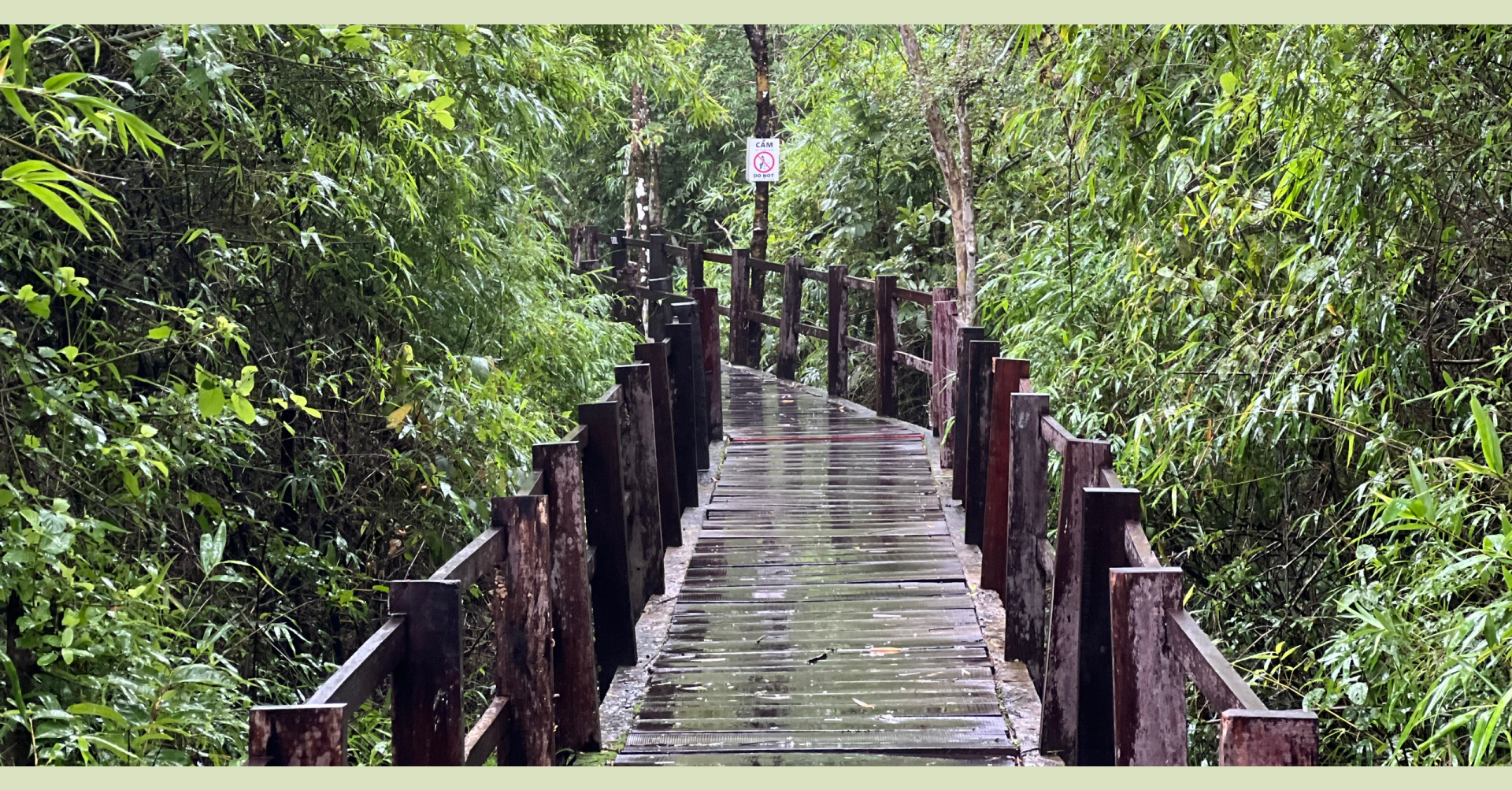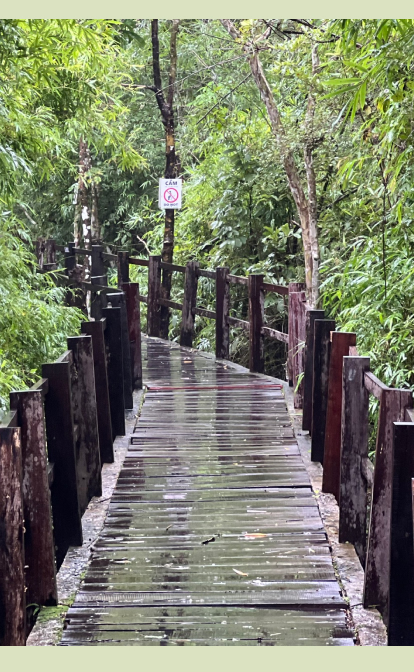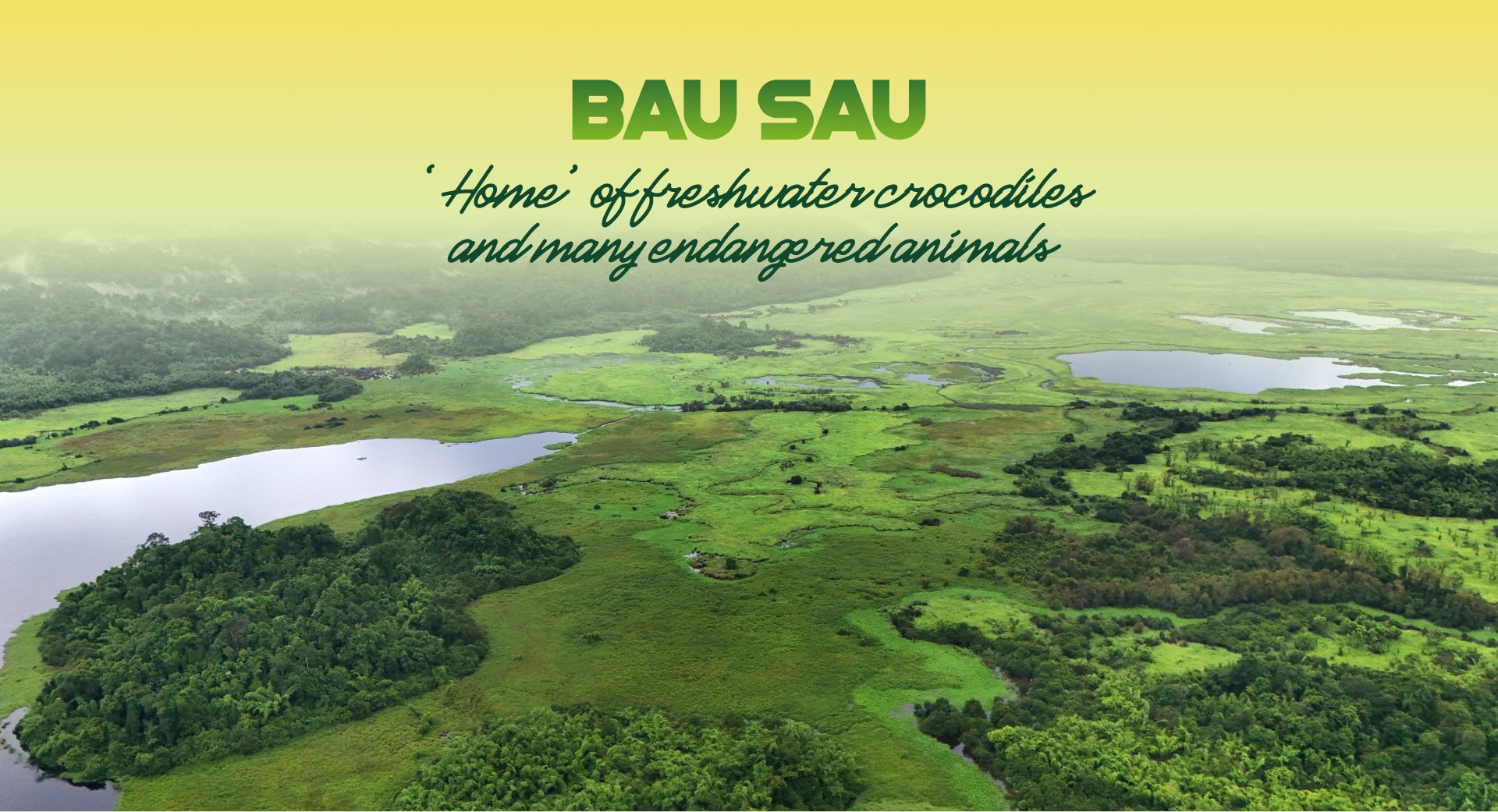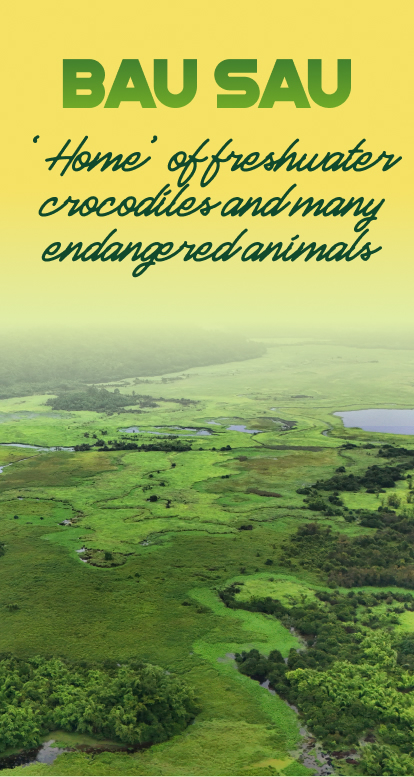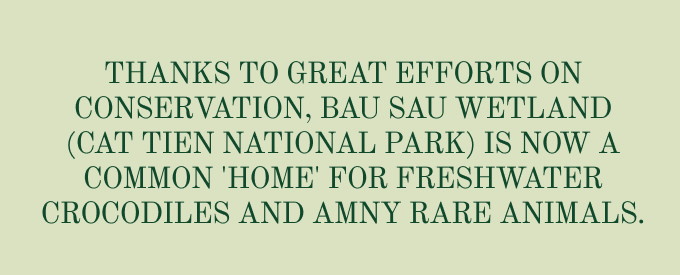
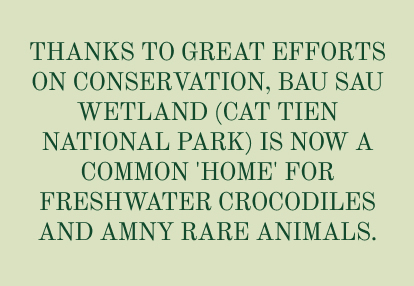
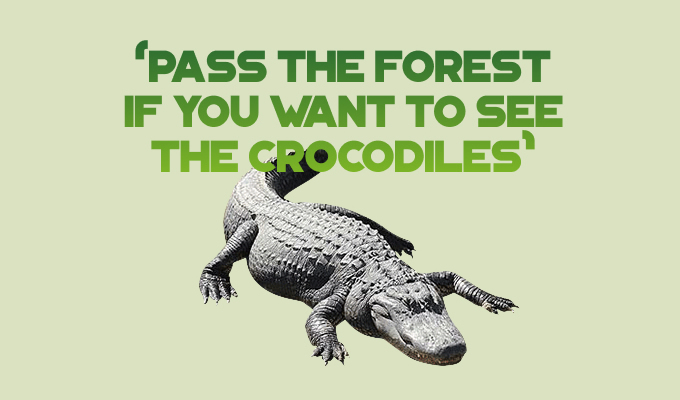
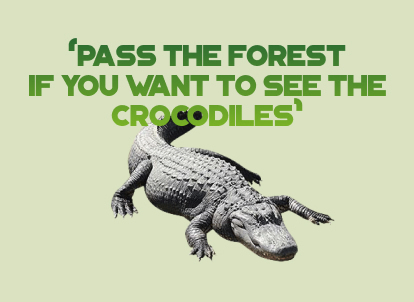
Upon arrival at Cat Tien National Park, we received a walm welcome from Bui Quoc Vi, a ranger and tour guide of the park. It was early afternoon, and the sky was gloomy as if its tears were about to come down.
Vi urged us to quickly pack our things and head to Bau Sau, because after traveling by car for 10 km, we had to walk another 5 km through the forest to get there. If we didn’t leave right away, it might be dark by the time we got there, making it difficult to take photos and film.
And so, without no time to rest, we immediately set off with Vi as our guide. After traveling nearly 10 km on a tourist bus, we arrived at the starting point for the trek to Bau Sau. It was raining, but not heavy enough to wet our bodies after traveling a long distance. Each person bought out a thin raincoat. They put it on and started trekking.

For more than 20 years as a forest ranger, having passed through the forest path leading to Bau Sau countless times, Vi seemed to know by heart each and every tree, every stone on the road, even down to the bird songs. While walking, Vi took the opportunity to introduce to us many species of trees that we had never seen before, especially those with strange shapes or exceptional sizes.
There were times when he suddenly stopped when a bird sang on a high branch. When the bird finished singing, Vi immediately told us what kind of bird it was and how rare of an existence it was. Watching him passionately introduce each species of tree, one could see how much this forest ranger loved the forest and wild animals.
Passing by an ancient tung tree (Tetrameles nudiflora R. Br.) with a huge root system that required more than ten people to hug, we decided to stop and rest a bit and learn more about this tree. Vi revealed that this tung tree was several hundred years old. It was much larger than other tung trees that tourist groups often come to take pictures of because they were near the road where tourist vehicles could travel.
Interspersed between stories about trees and animals in Cat Tien National Park were thrilling stories about the forest paths that Vi had witnessed or heard about. Among the stories about forest paths, some were creepy, some were tragic and haunting, but they helped us forget the long journey and the raindrops falling one after another. And just like that, we walked through the forest toward Bau Sau.
After more than an hour of walking through the forest in the pouring rain, we finally arrived at Bau Sau. The rain stopped, the sky became brighter, and a picturesque scene with a lake hundreds of hectares wide lies before our eyes. Lawns and green primeval forests are all around the lake, coating the green forest picture with a faint layer of wilderness and quietness.
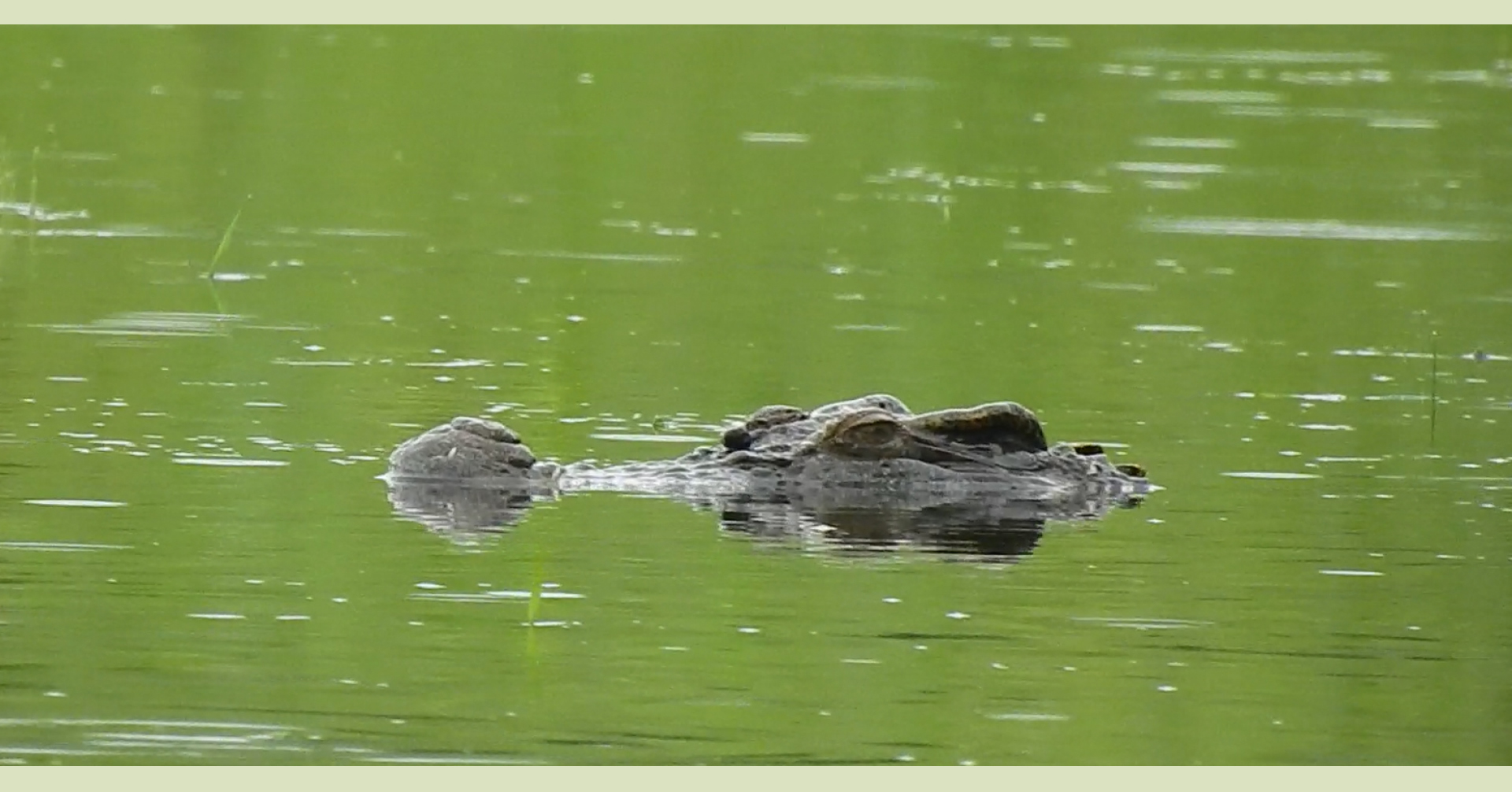
Without any time to catch a breath, we hurriedly took out our cameras to capture the most beautiful images of Bau Sau and the freshwater crocodiles, also known as Siamese crocodiles. Vi did not rest but continued to be a dedicated guide. He observed the entire surface of Bau Sau, and whenever he saw a crocodile appear, he immediately informed us so that we could promptly move our cameras.
Thanks to Vi’s enthusiastic guidance and some self-observation, we promptly recorded vivid and realistic images of freshwater crocodiles in Bau Sau. Not only the large and mature crocodiles appeared, there were also baby crocodiles – living proof that freshwater crocodiles are growing steadily here.
The crocodiles were sometimes almost motionless on the water surface, sometimes swimming leisurely and slowly in the lake. All of these images are proof that Bau Sau is truly a “home” for freshwater crocodiles to enjoy a peaceful life in the wild.
Not only did he look to see where the crocodiles appeared, Vi also observed the shore and pointed out to us the birds that were foraging on the grass around Bau Sau, including rare species such as the green peafowl.
Hearing the joyful cheers and seeing his joyful face every time he discovered a freshwater crocodile or a rare bird, we all gave out a wide smile. We felt his love for nature and the forest, for every tree and every animal in Cat Tien. This veteran ranger wanted to fully convey it to all those who had not hesitated to travel far and wide to witness this green forest and clear water.

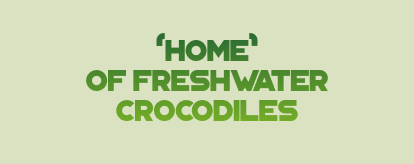
In Cat Tien National Park, there are many wetlands such as Snail Lake, Lotus Lake, Bird Lake, Water Hyacinth Lake, Crocodile Lake, etc. These names were given by the local people based on the names of the common animals and plants there. Among them, Crocodile Lake, or Bau Sau as normally called, has the widest area. The water surface area of Bau Sau is from 100 to 150 ha in the dry season, and expands to more than 2,500 ha in the rainy season.
In the past, there were countless freshwater crocodiles living in Bau Sau as well as the wetlands in Cat Tien National Park. There were so many that Cat Tien amassed countless thrilling jungle stories related to this species.
Due to poaching for their skins to make fashion products, the number of freshwater crocodiles in Cat Tien in general and Bau Sau in particular have decreased dramatically. By 1987, only a few individuals remained in Bau Sau.
A few years later, no trace of any individuals was found. This was a common situation in all places where freshwater crocodiles live in the wild, from Vietnam to Southeast Asian countries such as Thailand, Laos, Cambodia and Indonesia.
“The freshwater crocodile is considered one of the most endangered and less known crocodile species in the world,” said Nguyen Dinh Quoc Viet, Deputy Director of the Center for Environmental Education and Services, Cat Tien National Park.
According to the International Union for Conservation of Nature (IUCN), since 1992 this species has been considered extinct in the wild and in 1996 it was classified as CR - Critically Endangered. The status of the freshwater crocodile has not changed thus far. In the past, freshwater crocodiles were widely distributed throughout Southeast Asia, and might have been present in some islands in Indonesia and Malaysia (Simpson, Bezuijen, & Plan, 2010). Since 2000, there have been many surveys of freshwater crocodiles in the wild. The results recorded that freshwater crocodiles are still present in the wild, but the populations are fragmented and severely reduced.
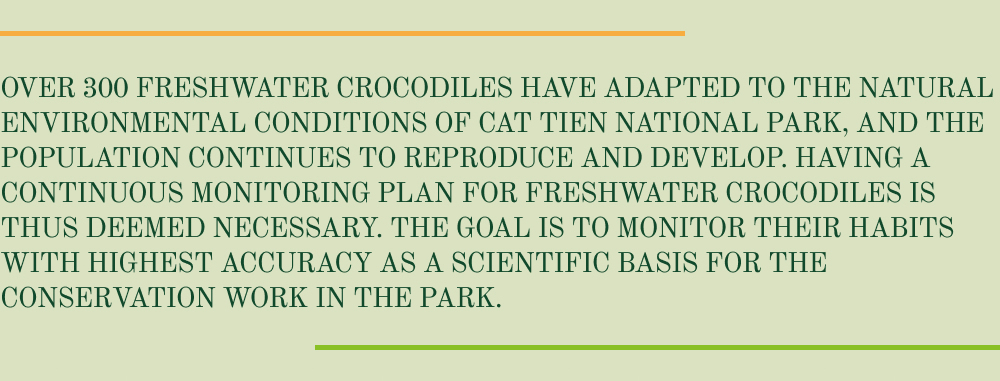
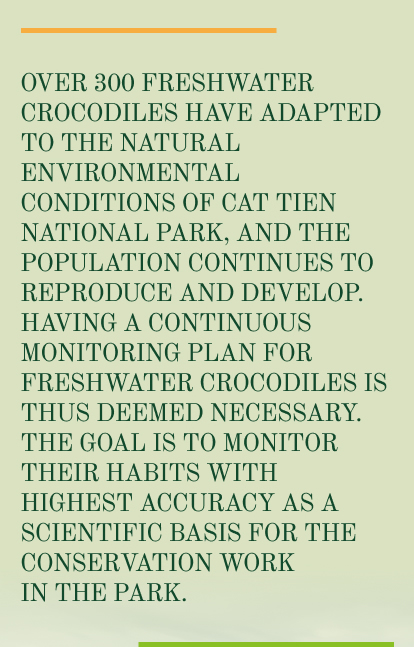
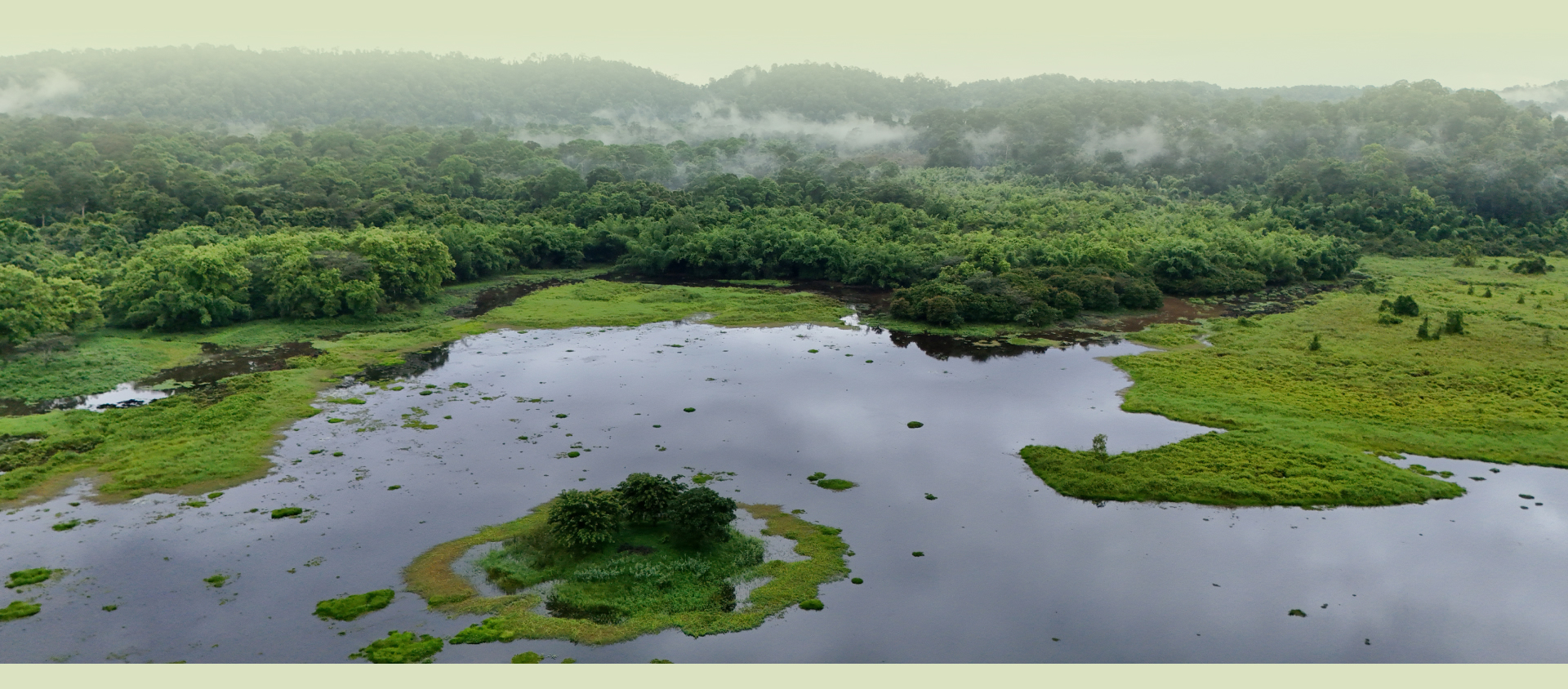

In 2000, Cat Tien National Park began the Freshwater Crocodile Restoration Project to preserve gene sources and ensure the balance of the wetland ecosystem here. With the support of domestic and foreign scientists, the project began searching for purebred Siamese crocodiles from crocodile farms.
The selected freshwater crocodiles, in addition to ensuring their purity through DNA testing, must also meet standards such as being over 2 years old and having a length of over 1.5 m. Before being released into the wild, these crocodiles were raised in a semi-wild environment and trained by scientists to restore their natural instincts such as hunting and incubation. Once these behaviors have been mastered, the crocodiles are released into Bau Sau in a team of 3 individuals (1 male and 2 females) at a time.
In 2001, when the road to Bau Sau was still rough along the forest with rocky soil, Cat Tien National Park had wooden crates made to look like shipping crates with width and length equal to the crocodiles’ bodies. The “packages” were then transported to Bau Sau on bicycles through the forest. The group of human had to walk, push, carry, and shoulder the heavy crocodiles over long distances to reach Bau Sau and release the first Siamese crocodiles back into the wild.
By 2004, 60 purebred freshwater crocodiles had been released into Bau Sau. In 2005, although the number of crocodiles surviving in the wild was only 9, scientists and officials of Cat Tien National Park were able to observe baby crocodiles floating on the water surface. This was evidence that the growth process of Siamese crocodiles in the wild resulted in a population of crocodiles that mated, successfully hatched eggs, and created new generations of crocodiles for Cat Tien.
In the following years, the number of freshwater crocodiles living in Bau Sau increased day by day. In 2013, there were 92 individuals. In 2014, there were 97 individuals. In 2015, there were 152 individuals. In 2016, there were 177 individuals. By 2019, there were nearly 300 Siamese crocodiles living in Bau Sau.
With this number, combined with the fact that the crocodiles have completely adapted to the natural environment, the freshwater crocodile recovery program in Bau Sau can be considered a success. Today, Bau Sau is the only wild environment in Vietnam where freshwater crocodiles thrive.
According to Nguyen Dinh Quoc Viet, biodiversity investigation and monitoring work has been very limited in recent years due to funding difficulties, although these items have been approved by the Ministry of Agriculture and Rural Development under Decision No. 1535/QD-BNN-TCLN dated July 11, 2011 on the conservation and sustainable development planning of Cat Tien National Park in the 2010 - 2020 period.


Although there are hundreds of freshwater crocodiles growing steadily in Bau Sau, in general, this species remains in a very endangered state. According to the Vietnam Red Book, freshwater crocodiles (Crocodylus siamensis) are large reptiles belonging to the Crocodile family (Crocodylidae), Crocodile order (Crocodylia). Freshwater crocodiles have a body length of 2.2 - 2.3 m (the largest freshwater crocodile ever known had a length of up to 4 m).
In terms of appearance, freshwater crocodiles have a long snout, and their entire body is covered with horny plates. The horny plates on the back are rectangular in shape, adjacent to each other in horizontal rows. The crocodile's tail is large and strong, with four ridges on the surface. The crocodile's hind legs have swimming membranes connecting the toes. Freshwater crocodiles have a gray body, and the belly has lighter color than the back.
Freshwater crocodiles usually live in large rivers, lakes or swamps, where the water is still or slow-flowing. They live mainly in water, only coming out on land on hot days to regulate their body temperature. The main food of freshwater crocodiles is fish, crabs, frogs, birds and small animals such as mice. In domesticated conditions, they can also eat dead prey (waste from cattle, pigs, and chicken slaughterhouses).

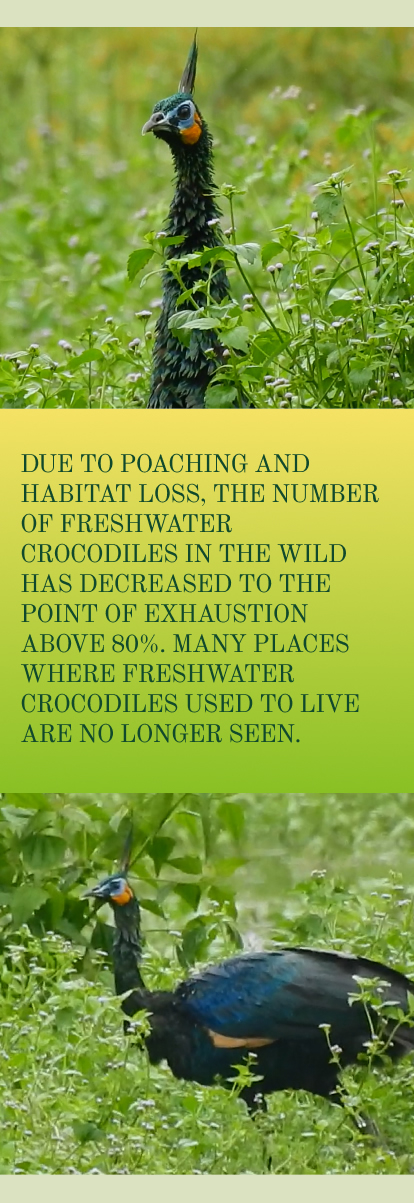
Freshwater crocodiles’ mating season spans from December to March, when the adult reaches a minimum size of aproximately 1.8 m. They lay eggs once a year at the beginning of the rainy season from April to October, each time laying 15 - 26 eggs (sometimes up to 40 eggs).
The crocodile would dig a hole 0.5 m deep and 0.8 m wide a week before and then lays eggs there at night. After laying, the mother crocodile covers the egg nest with dry, rotten branches and leaves to form a mound up to 0.5 m high. The mother crocodile has the tendency to protect the eggs. The eggs hatch 75 - 85 days after laying. Newborn crocodiles are usually 200 - 300 mm long.
Freshwater crocodiles have been recorded living in the provinces of Kon Tum (Sa Thay River), Gia Lai (Ba River), Dak Lak (Ea Sup River, Krong Ana River, Lak Lake, Krong Pach Thuong Lake), Khanh Hoa, Dong Nai (South Cat Tien), and the Mekong Delta (Cuu Long River). This species also lives in many Southeast Asian countries beside Vietnam such as Thailand, Laos, Cambodia, Malaysia, and Indonesia.
In Vietnam, freshwater crocodiles have been classified as critically endangered (CR), and hunting and trading are absolutely prohibited. The Vietnamese government encourages the breeding of freshwater crocodiles to protect their genetic resources. There are projects to release this species into national parks where they used to live. The government also finds it crucial to raise public awareness about protecting freshwater crocodiles.


Bau Sau is actually the general name for all wetlands in Cat Tien National Park. In 2005, Bau Sau wetland was recognized as the 1,499th Ramsar site in the world and the second in Vietnam. A large part of the natural lowland wetlands at Bau Sau have experienced relatively little human impact and are important habitats for many threatened species of flora and fauna.
According to Cat Tien National Park, Bau Sau is a lowland area in the core of the most important tropical rainforest in Southern Vietnam. It covers an area of 13,759 ha, including year-round and seasonal flooded areas, clusters of sandbanks, islands, and surrounding green areas. Of which, the wetland area in the rainy season is estimated at 5,360 ha, and narrows to 151 ha during the peak of the dry season.
Having a large area and diverse habitats, Bau Sau is not only the "home" of freshwater crocodiles but also hundreds of species of animals and plants, including rare species listed in the Vietnam Red Book such as green peafowl, gaurs, lesser adjutant, sambar, etc.
Bau Sau is considered an ideal habitat for gaurs in pảticular. Gaurs are often seen both at night and during the day at all times of the year, especially in the dry season, from November to June of the following year. At that time, the water level is low, creating conditions for grass to grow into large young grass fields along the lake.
Statistics of Ramsar sites (1999) show that Bau Sau wetland has 82 mammal species, an extremely rich number of birds with 318 species, 58 reptile species and 28 amphibian species. The total number of species living in Bau Sau Cat Tien habitat is 486 species. The biodiversity here is the highest in the list of national parks in Vietnam compared in the same data table (including Cuc Phuong, Yok Don, Ba Vi, Bach Ma, Ba Be, Ben En, Con Dao, and Cat Ba National Parks).
With beautiful landscapes and a very high level of biodiversity, for many years, Bau Sau wetland has become an important ecotourism destination in Cat Tien National Park, contributing to making the park increasingly attractive to domestic and foreign tourists. When coming to Bau Sau, many tourists choose to stay overnight at Bau Sau Ranger Station to have the most complete and interesting experiences of the wild nature here.


